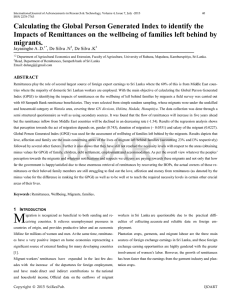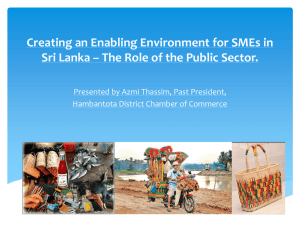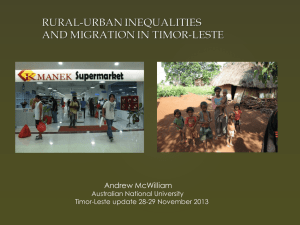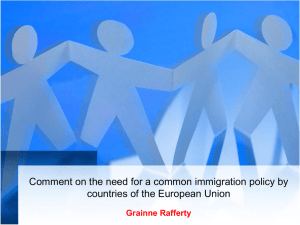Roshini Jayaweera - Institute of Policy Studies
advertisement
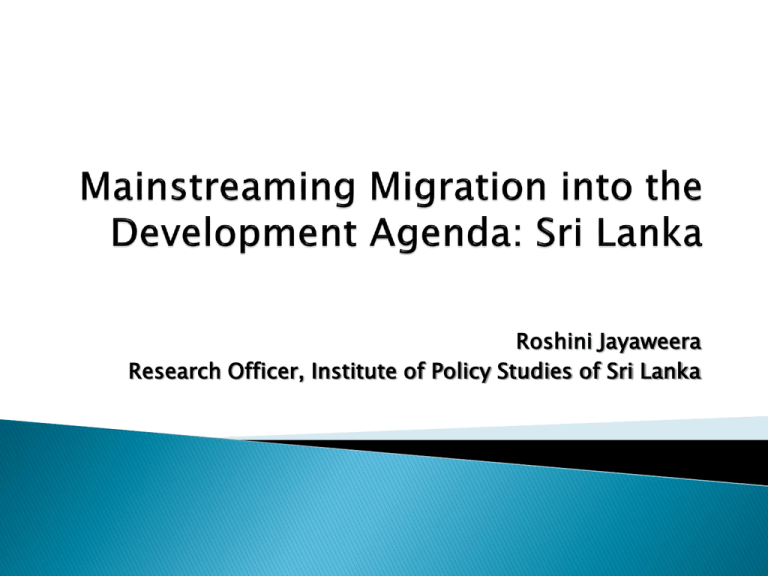
Roshini Jayaweera Research Officer, Institute of Policy Studies of Sri Lanka Introduction Objective Why should migration be a main concern ? Policies and Proposals Conclusion Process of assessing the implications of migration in any goal planned in development and poverty reduction strategy Broader development strategy Coordination among different institutions Mainstreaming Migration into Development Gaps in existing legislative and policy frameworks Funding and technical assistance The outflow of Sri Lankan workers has shown an increasing trend A surge in inflows of remittances There is a significant impact of migration and remittances on development ‘Migration policies’ and ‘development policies’ have been treated separately Migration needs to be mainstreamed into Development Agenda Answer 6 Questions Global Migration Group (2010), Mainstreaming Migration into Development Planning: A Handbook for Policy Makers and practitioners, IOM Does the country have large stocks of migrants?/What have recent patterns of migration been? What sorts of experiences are migrants having? Are there sizeable financial transfers or remittances from migrants? Are there any possible effects, positive or negative, of these migration trends? Is migration a prominent issue in public or political debates? Is there political will/interest in harnessing migration for development? To what extent, migration has already been incorporated into Sri Lankan development agenda Departures for Foreign Employment, by Gender (%), (1986-2011) Sri Lanka has a large stock of migrants. This stock comprises of both men and women. Source: Annual Statistics Handbook of Foreign Employment, 2011, SLBFE. Departures for Foreign Employment by Age Group (2007-2011) Majority of Sri Lankan migrant workers are young. Source: Annual Statistics Handbook of Foreign Employment, 2011, SLBFE. Departures for Foreign Employment by Manpower Groups (1994-2010) The major market for Sri Lankan labour is the Middle East. Unskilled labour migration is a prominent feature relevant to Sri Lankan out-migration. Source: Annual Statistics Handbook of Foreign Employment, 2010, SLBFE. Malaysia, Jordan, and K.S.A, can be identified as riskier countries Migration experience does not affect men and women in the same way. ◦ In 2011, more than 9000 complaints. ◦ Nonpayment of agreed wage and the breach of employment contract. ◦ Of both, the majority of complaints came from female migrant workers. ◦ Nonpayment of agreed wage - almost 80 % of complaints from female migrant workers ◦ Breach of contracts - 58 % from female. ◦ Another considerable percentage (15 per cent) of complaints is about physical and sexual harassment, and 96 per cent of total complaints are from female migrant workers. 100 90 % of complaints 80 70 60 50 40 30 20 10 0 Nature of Complaints male female Total Source: Annual Statistics Handbook of Foreign Employment, 2011, SLBFE. Remittances Inflows to Sri Lanka by Region (2005-2011) Trends in Remittance Inflows (% of GDP)- 1990-2010 9 5000 8 4000 7 %6 U 3000 S o5 f $ 4 G D P3 2000 M n 2 1000 1 0 0 Year Remittances As a % of GDP Source: Central Bank Annual Report, Various Issues. Inflow of Remittances> FDI & ODA Less Volatility Counter-Cyclical Role % of GDP 1991-1994 1995-1999 2000-2004 2005-2010 Domestic Savings 16.5 17.3 16 17.2 National Savings 20.5 21.4 21 22.6 Total Investment 19.9 25.4 23.7 27.1 Source: Central Bank of Sri Lanka, various issues. Number of Migrants Unemployment Domestic Demand for Carpenters/ Masons 12% increase in nominal wages Shortages of Carpenters Source: Central Bank of Sri Lanka , Annual Report, Distribution of Remittance Receiving Households by Expenditure Deciles 1st 100 Higher expenditure on food, non-food, education, health, durable goods, and housing Return is lower 10th 2nd 80 60 40 9th 3rd 20 0 8th 4th 7th 5th 6th % of HHs receiving remittances Remittances as a % of Total HH income Source: MFEPW (2011) There is a political will and interest in harnessing migration for development Establishment of the Ministry of Foreign Employment Promotion and Welfare Recruitment Policies and Proposals Remittances Return Reintegration National Migration Policy in Sri Lanka Signing of MOUs bilateral and agreements Welfare programmes for migrant workers Human Resource Development Well-developed financial system MFEPW introduced special debit cards for migrant workers Bilateral agreements/MoUs ? Migration was identified as an important development issue when the ‘Mahinda Chintana: Vision for the Future’. It aims ◦ increase male migration by 50 per cent. ◦ to secure more than 50,000 employment opportunities in several countries including Korea, Japan, and Libya; ◦ to expand the opportunities for those with skills in specialized fields such as nursing, nautical services, accountancy, IT, banking, and engineering to enter the international labour market; ◦ to maintain a foreign employment provident fund for all migrant workers. ◦ It suggests improvement in the level of diaspora engagement in development activities and returnee reintegration. ◦ to establish a dedicated bureau in order to identify and resolve problems faced by Sri Lankans living in abroad and create a conducive environment in Sri Lanka for them to live upon their return to Sri Lanka ◦ to create an attractive bonus scheme for Sri Lankans who send their foreign exchange to Sri Lanka. There are sufficient policies that have been implemented by the government ◦ to increase the number of migrants ◦ to increase the volume of remittance ◦ to protect migrant workers However, there are some aspects of migration which have been neglected by these polices. ◦ stimulation of investment of remittance ◦ stimulation of sound remittance management ◦ returnee reintegration Stimulate Invetment • Introduction of SME programmes • Microfinance facilities to start self-employment • tax breaks on imports of capital goods Remittance Management • financial education Thank You
